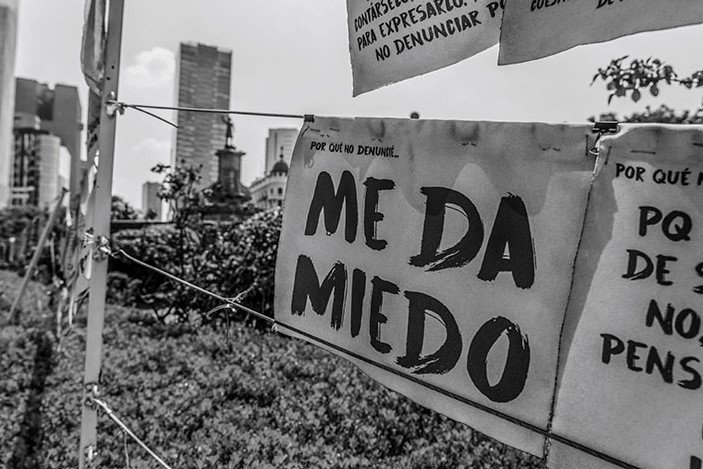Social movements claim public space in one of the largest cities in the Americas.
Every morning, taxi drivers in Mexico City weave through traffic while tuning in to radio announcements of marches and demonstrations. Protests—colorful, loud, and insistent—are a constant presence throughout the metropolis of 8.5 million people. Over the years, it has been easy to step out of a downtown hotel in the morning, walk a block up to the Reforma (Mexico City’s central avenue), and join the crowds with my camera. Much of the political life of the city is found in the street, and its social movements use public space often as a reminder of earlier protests and actions that gave form to Mexican politics.
Those politics reflect an interplay between grassroots demands and a more formal electoral process. Today, following a new, more open procedure for choosing presidential candidates (which is itself, in part, a product of peoples’ movements), Mexico’s governing party Morena (the Movement for National Regeneration) chose the city’s mayor, Claudia Sheinbaum, as its candidate for the presidential election next June. Given the popularity of Morena and its founder, current President Andres Manuel Lopez Obrador, she is virtually certain to be elected.
Sheinbaum is an engineer, a skilled politician, and the daughter of a leftist family. If elected, she will be Mexico’s first female head of state, joining a growing number of women who head or have headed governments throughout the Americas (notably not including the United States).
It’s not just women in office changing politics—the country’s Supreme Court recently struck down the prohibition of abortion. Women have been protesting abuse and gender-based violence for years, especially since the disappearance of scores of young maquiladora workers in Juarez, on the U.S.-Mexico border. It’s no surprise, then, that women have taken over a traffic island in the middle of the Reforma to highlight these attacks and demand justice.
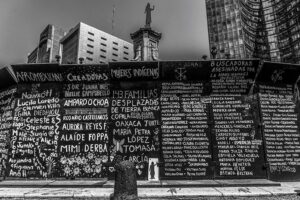
A metal, violet-colored silhouette of a woman with her fist in the air rises above the corrugated walls of a kiosk. The surfaces have first been painted back, and then the names of women murdered or subjected to repression have been hand lettered in white.
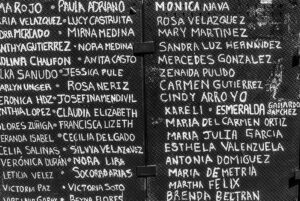
The number of names is extraordinary. Each panel of the kiosk emphasizes repression directed towards a particular group: One displays the names of women journalists; another lists Indigenous activists. It includes Bety Cariño, ambushed and killed in 2010 as she brought support to an autonomous Triqui town in Oaxaca, and Digna Ochoa, a defender of the poor, shot in her Mexico City office in 2001.
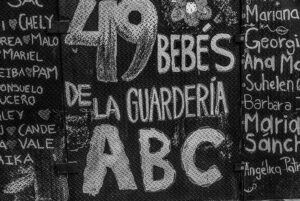
A third panel memorializes the forty-nine children burned to death in the ABC nursery in 2009.
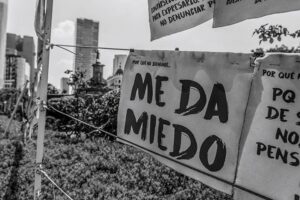
On paper banners hung on strings at the edge of the curb are the words of ordinary women, giving accounts of abuse: “Because of fear, because of reprisals, because I was not protected,” or “Because he was family, I was afraid of what they’d think of me, and when I told my mother, and she told his mother, they said I’d probably provoked him,” or simply, “He scares me.”
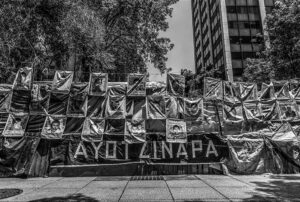
Further up the Reforma is another permanent memorial. Not far from the guarded facade of the U.S. Embassy, and the buildings housing rich banks and government offices, is the Ayotzinapa encampment.
Nine years ago, students set out in commandeered buses from their teachers’ training school in Guerrero to the annual march commemorating the death of hundreds of students in the city’s Tlatelolco Plaza in 1968. Forty-three Ayotzinapa students were seized and disappeared. Through those nine years, the investigations into the perpetrators have reached into the highest levels of the government, especially the armed forces. While previous administrations tried to pretend the students were simply victims of a narcotics cartel, it has become clear that there were deep political reasons for their murder.
The Ayotzinapa school itself has been the target of the Mexican right for its history of training rural teachers. The school gave students a radical and Marxist analysis of their country, preparing them to be social organizers, even revolutionaries. It followed the tradition of one of its best known professors, Lucio Cabañas, who took up arms against the Mexican government in the 1960s.
Since 2014, new generations of Ayotzinapa students have kept up pressure on the government by coming to the capital every month. They have built a permanent camp on the Reforma, with cabins and shelters for sleeping and space for meetings. Surrounding it are silk-screened images of the disappeared students, strung in rows on the shelter’s walls, facing the traffic. This planton, or encampment, even boasts a small library, cared for by Martin, one of a group dedicated to maintaining the space.
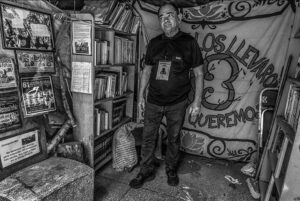
Public space is contested space for protest movements in any city. In some, every effort to create a permanent presence is greeted with fire hoses, arrests, and worse. Mexico City has its own history of trying to sweep social movements out of sight. But a tradition of popular protest is equally strong, including the planton. It has popular recognition, which the government must take into account.
Perhaps the Ayotzinapa encampment, and the Glorieta de las Mujeres que Luchan (the Roundabout of the Women in Struggle) are products of a certain political moment. But perhaps they will become as much a part of the recognized life of the city as the Angel of Independence, the column that has towered over the Reforma since 1910, the first year of the Mexican Revolution.
The two occupations of public space each mark their own watershed in Mexican politics, and that change, with or without memorials, will perhaps last decades as well.
David Bacon | A former union organizer for thirty years, David Bacon’s photoessays and stories seek to capture the courage of people struggling for social and economic justice in countries around the world.
El Tribuno del Pueblo brings you articles written by individuals or organizations, along with our own reporting. Bylined articles reflect the views of the authors. Unsigned articles reflect the views of the editorial board. Please credit the source when sharing: tribunodelpueblo.org. We’re all volunteers, no paid staff. Please donate at http://tribunodelpueblo.org to keep bringing you the voices of the movement because no human being is illegal.

